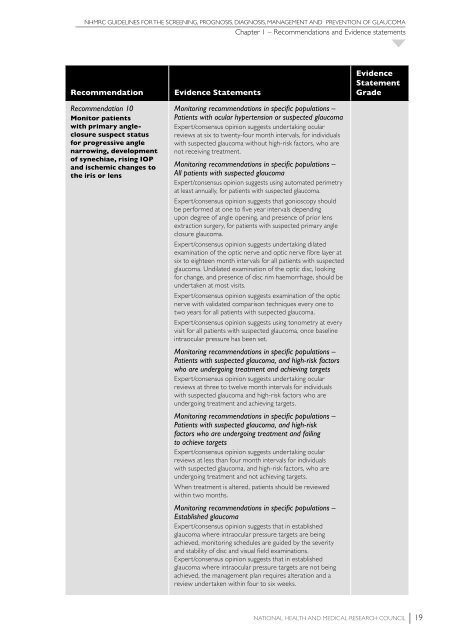NHMRC Glaucoma Guidelines - ANZGIG
NHMRC Glaucoma Guidelines - ANZGIG
NHMRC Glaucoma Guidelines - ANZGIG
You also want an ePaper? Increase the reach of your titles
YUMPU automatically turns print PDFs into web optimized ePapers that Google loves.
<strong>NHMRC</strong> GUIDELINES FOR THE SCREENING, PROGNOSIS, DIAGNOSIS, MANAGEMENT AND PREVENTION OF GLAUCOMA<br />
Chapter 1 – Recommendations and Evidence statements<br />
Recommendation<br />
Recommendation 10<br />
Monitor patients<br />
with primary angleclosure<br />
suspect status<br />
for progressive angle<br />
narrowing, development<br />
of synechiae, rising IOP<br />
and ischemic changes to<br />
the iris or lens<br />
Evidence Statements<br />
Monitoring recommendations in specific populations –<br />
Patients with ocular hypertension or suspected glaucoma<br />
Expert/consensus opinion suggests undertaking ocular<br />
reviews at six to twenty-four month intervals, for individuals<br />
with suspected glaucoma without high-risk factors, who are<br />
not receiving treatment.<br />
Monitoring recommendations in specific populations –<br />
All patients with suspected glaucoma<br />
Expert/consensus opinion suggests using automated perimetry<br />
at least annually, for patients with suspected glaucoma.<br />
Expert/consensus opinion suggests that gonioscopy should<br />
be performed at one to five year intervals depending<br />
upon degree of angle opening, and presence of prior lens<br />
extraction surgery, for patients with suspected primary angle<br />
closure glaucoma.<br />
Expert/consensus opinion suggests undertaking dilated<br />
examination of the optic nerve and optic nerve fibre layer at<br />
six to eighteen month intervals for all patients with suspected<br />
glaucoma. Undilated examination of the optic disc, looking<br />
for change, and presence of disc rim haemorrhage, should be<br />
undertaken at most visits.<br />
Expert/consensus opinion suggests examination of the optic<br />
nerve with validated comparison techniques every one to<br />
two years for all patients with suspected glaucoma.<br />
Expert/consensus opinion suggests using tonometry at every<br />
visit for all patients with suspected glaucoma, once baseline<br />
intraocular pressure has been set.<br />
Monitoring recommendations in specific populations –<br />
Patients with suspected glaucoma, and high-risk factors<br />
who are undergoing treatment and achieving targets<br />
Expert/consensus opinion suggests undertaking ocular<br />
reviews at three to twelve month intervals for individuals<br />
with suspected glaucoma and high-risk factors who are<br />
undergoing treatment and achieving targets.<br />
Monitoring recommendations in specific populations –<br />
Patients with suspected glaucoma, and high-risk<br />
factors who are undergoing treatment and failing<br />
to achieve targets<br />
Expert/consensus opinion suggests undertaking ocular<br />
reviews at less than four month intervals for individuals<br />
with suspected glaucoma, and high-risk factors, who are<br />
undergoing treatment and not achieving targets.<br />
When treatment is altered, patients should be reviewed<br />
within two months.<br />
Monitoring recommendations in specific populations –<br />
Established glaucoma<br />
Expert/consensus opinion suggests that in established<br />
glaucoma where intraocular pressure targets are being<br />
achieved, monitoring schedules are guided by the severity<br />
and stability of disc and visual field examinations.<br />
Expert/consensus opinion suggests that in established<br />
glaucoma where intraocular pressure targets are not being<br />
achieved, the management plan requires alteration and a<br />
review undertaken within four to six weeks.<br />
Evidence<br />
Statement<br />
Grade<br />
National Health and Medical Research Council 19





